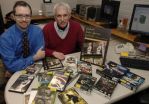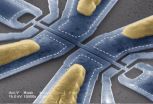(Press-News.org) A superconductor, which can move electrical energy with no wasteful resistance, is the holy grail of cost-effective, efficient, and "green" power production. Unlike traditional conductors such as copper or silver, which waste power resources and lose energy when they heat up, an ideal superconductor would continuously carry electrical current without losing any power.
But creating a true superconductor is tricky. Though the concept of high temperature superconductors is more than two decades old, finding and controlling the right materials has been a challenge. Now Prof. Yoram Dagan of Tel Aviv University's Department of Physics and Center for Nanoscience and Nanotechnology has discovered an innovative way to manipulate superconducting materials.
Temperature is a crucial element for superconductors, explains Prof. Dagan — each material has a critical temperature when it becomes superconducting. But by manipulating different types of light, including UV and visible light, he and his fellow researchers are able to alter the critical temperatures of superconducting materials. This finding adds to a growing toolbox for controlling and improving the technology.
The research has been published in Angewandte Chemie and featured in Nature Nanotechnology.
Shining a light
Scientists have long sought ways to alter the temperature of superconducting materials, making them more practical. One of these methods includes chemical doping, removing or adding ions such as oxygen to alter the critical temperature of the material. But Prof. Dagan said that he and his fellow researchers were inspired to find a simpler way.
In the lab, they put a thin layer, one organic molecule thick, atop a superconducting film, approximately 50 nanometers thick. When researchers shined a light on these molecules, the molecules stretched and changed shape, altering the properties of the superconducting film — most importantly, altering the critical temperature at which the material acted as a superconductor.
The researchers tested three separate molecules. The first was able to increase the critical temperature of the superconducting film. With the second molecule, they found that shining an ultraviolet light heightened the material's critical temperature, while visible light lowered it. Finally, with the third molecule, they found that simply by turning a light on, critical temperature was raised — and lowered again when the light was switched off. Prof. Dagan calls this discovery a new "knob" for controlling the temperature of superconducting materials.
Small changes, big impact
The power of this finding is that instead of changing the temperature of the material itself, a more complicated process, the material can remain at the same temperature when the film is altered. This is a small change that results in very large responses from devices, says Prof. Dagan: "It's a strong response for a small amount of light."
One of the potential future applications of this finding might be a "non-dissipated memory," which would be able to save data and run continuously without generating heat and wasting energy.
INFORMATION:
This research, a collaboration between the Departments of Physics, Chemistry, and the Center for Nanoscience and Nanotechnology, included Drs. Michael Gozen and Shachar Richter, Post-Doctoral Fellow Dr. Itai Carmeli, and graduate student Avraham Lewin on the team.
American Friends of Tel Aviv University (www.aftau.org) supports Israel's leading, most comprehensive and most sought-after center of higher learning. Independently ranked 94th among the world's top universities for the impact of its research, TAU's innovations and discoveries are cited more often by the global scientific community than all but 10 other universities.
Internationally recognized for the scope and groundbreaking nature of its research and scholarship, Tel Aviv University consistently produces work with profound implications for the future.
Controlling superconductors with light
Tel Aviv University researcher discovers that a ray of light could lead to the next generation of superconductors
2012-08-27
ELSE PRESS RELEASES FROM THIS DATE:
Little evidence supports autism treatment options in adolescents
2012-08-27
Vanderbilt University researchers studying interventions for adolescents and young adults with autism are reporting today that there is insufficient evidence to support findings, good or bad, for the therapies currently used.
Although the prevalence of autism is on the rise, much remains to be discovered when it comes to interventions for this population, the researchers concluded.
"Overall, there is very little evidence in all areas of care for adolescents and young adults with autism, and it is urgent that more rigorous studies be developed and conducted," said Melissa ...
Arctic sea ice reaches lowest extent ever recorded, says CU-Boulder research team
2012-08-27
The blanket of sea ice floating on the Arctic Ocean melted to its lowest extent ever recorded since satellites began measuring it in 1979, according to the University of Colorado Boulder's National Snow and Ice Data Center.
On Aug. 26, the Arctic sea ice extent fell to 1.58 million square miles, or 4.10 million square kilometers. The number is 27,000 square miles, or 70,000 square kilometers below the record low daily sea ice extent set Sept. 18, 2007. Since the summer Arctic sea ice minimum normally does not occur until the melt season ends in mid- to-late September, ...
Special international commission on media violence confirms aggression link
2012-08-27
AMES, Iowa -- As president of the International Society for Research on Aggression (IRSA) and with consent of the organization's elected council, Craig Anderson appointed an international Media Violence Commission last December to prepare a public statement on the known effects of media violence exposure, based on the current state of scientific knowledge. The Iowa State University Distinguished Professor of psychology appointed 12 IRSA researchers to the commission, including Douglas Gentile, an ISU associate professor of psychology.
The Media Violence Commission's research-based ...
CancerMedsCanada.com Partners with Great Canadian Pharmacy to Provide Cost-Effective Prescription Drugs Online
2012-08-27
CancerMeds Canada is an affiliate for a well-known leading global pharmacy intermediary GreatCanadianPharmacy.com. "Since 2004, our goal at GreatCanadianPharmacy.com is to provide consumers affordable Canada drugs through our unique network of licensed global pharmacies and Canadian pharmacies," explains the owner of CancerMedsCanada.com, Thomas Unger. "We aim to be one of the forerunners of premier prescription fulfillment service providers on the Web."
GreatCanadianPharmacy.com offers the cheapest and best drug prices for its consumers on the Web. ...
Mayo, UCSF team discovers genomic variant that increases risk of brain tumors
2012-08-27
ROCHESTER, Minn. -- People who carry a "G" instead of an "A" at a specific spot in their genetic code have roughly a six-fold higher risk of developing certain types of brain tumors, a Mayo Clinic and University of California, San Francisco study has found. The findings, published online today in the journal Nature Genetics, could help researchers identify people at risk of developing certain subtypes of gliomas which account for about 20 percent of new brain cancers diagnosed annually in the U.S. and may lead to better surveillance, diagnosis and treatment.
Researchers ...
UCSF, Mayo team discovers genomic variant that increases risk of some brain tumors
2012-08-27
People who carry a "G" instead of an "A" at a specific spot in the sequence of their genetic code have roughly a six-fold higher risk of developing certain types of brain tumors, according to a study by researchers at the University of California, San Francisco and Mayo Clinic.
The study was jointly led by geneticists Margaret Wrensch, PhD, and John Wiencke, PhD, professors in the Department of Neurological Surgery at UCSF, and Robert Jenkins, MD, PhD, professor of Laboratory Medicine in the Department of Laboratory Medicine and Pathology and the Division of Laboratory ...
New wave of technologies possible after ground-breaking analysis tool developed
2012-08-27
A revolutionary tool created by scientists at the University of Sheffield has enabled researchers to analyse nanometer-sized devices without destroying them for the first time, opening the door to a new wave of technologies.
The nuclear magnetic resonance apparatus – developed by the University's Department of Physics and Astronomy – will allow for further developments and new applications for nanotechnology which is increasingly used in harvesting solar energy, computing, communication developments and also in the medical field.
Scientists can now analyse nanostructures ...
A lesson in sleep learning
2012-08-27
Is sleep learning possible? A new Weizmann Institute study appearing today in Nature Neuroscience has found that if certain odors are presented after tones during sleep, people will start sniffing when they hear the tones alone – even when no odor is present – both during sleep and, later, when awake. In other words, people can learn new information while they sleep, and this can unconsciously modify their waking behavior.
Sleep-learning experiments are notoriously difficult to conduct. For one thing, one must be sure that the subjects are actually asleep and stay that ...
Weighing molecules 1 at a time
2012-08-27
PASADENA, Calif.—A team led by scientists at the California Institute of Technology (Caltech) have made the first-ever mechanical device that can measure the mass of individual molecules one at a time.
This new technology, the researchers say, will eventually help doctors diagnose diseases, enable biologists to study viruses and probe the molecular machinery of cells, and even allow scientists to better measure nanoparticles and air pollution.
The team includes researchers from the Kavli Nanoscience Institute at Caltech and Commissariat à l'Energie Atomique et aux ...
Controlling gene expression: How chromatin remodelers block a histone pass
2012-08-27
KANSAS CITY, MO—Two opposing teams battle it out to regulate gene expression on the DNA playing field. One, the activators, keeps DNA open to enzymes that transcribe DNA into RNA. Their repressor opponents antagonize that effort by twisting DNA into an inaccessible coil around histone proteins, an amalgam called chromatin, effectively blocking access to DNA by enzymes that elongate an RNA strand.
Both teams maneuver by chemically modifying histones—the activators by decorating histones with acetyl groups—let's call them green flags—causing them to loosen their grip on ...
LAST 30 PRESS RELEASES:
University of Oklahoma researcher awarded funding to pursue AI-powered material design
Exploring how the visual system recovers following injury
Support for parents with infants at pediatric check-ups leads to better reading and math skills in elementary school
Kids’ behavioral health is a growing share of family health costs
Day & night: Cancer disrupts the brain’s natural rhythm
COVID-19 vaccination significantly reduces risk to pregnant women and baby
The role of vaccination in maternal and perinatal outcomes associated with COVID-19 in pregnancy
Mayo Clinic smartwatch system helps parents shorten and defuse children's severe tantrums early
Behavioral health spending spikes to 40% of all children’s health expenditures, nearly doubling in a decade
Digital cognitive behavioral treatment for generalized anxiety disorder
Expenditures for pediatric behavioral health care over time and estimated family financial burden
Air conditioning in nursing homes and mortality during extreme heat
The Alps to lose a record number of glaciers in the next decade
What makes a good proton conductor?
New science reporting guide published for journalists in Bulgaria
New international study reveals major survival gaps among children with cancer
New science reporting guide published for journalists in Turkey
Scientists develop a smarter mRNA therapy that knows which cells to target
Neuroanatomy-informed brain–machine hybrid intelligence for robust acoustic target detection
Eight SwRI hydrogen projects funded by ENERGYWERX
The Lundquist Institute and its start-up company Vitalex Biosciences Announces Strategic Advancement of Second-Generation fungal Vaccine VXV-01 through Phase 1 Trials under $40 Million Competitive Con
Fine particles in pollution are associated with early signs of autoimmune disease
Review article | Towards a Global Ground-Based Earth Observatory (GGBEO): Leveraging existing systems and networks
Penn and UMich create world’s smallest programmable, autonomous robots
Cleveland researchers launch first major study to address ‘hidden performance killer’ in athletes
To connect across politics, try saying what you oppose
Modulating key interaction prevents virus from entering cells
Project explores barriers to NHS career progression facing international medical graduates
Jeonbuk National University researchers explore the impact of different seasonings on the flavor perception of Doenjang soup
Two Keck Medicine of USC Hospitals named Leapfrog Top Teaching Hospitals
[Press-News.org] Controlling superconductors with lightTel Aviv University researcher discovers that a ray of light could lead to the next generation of superconductors




